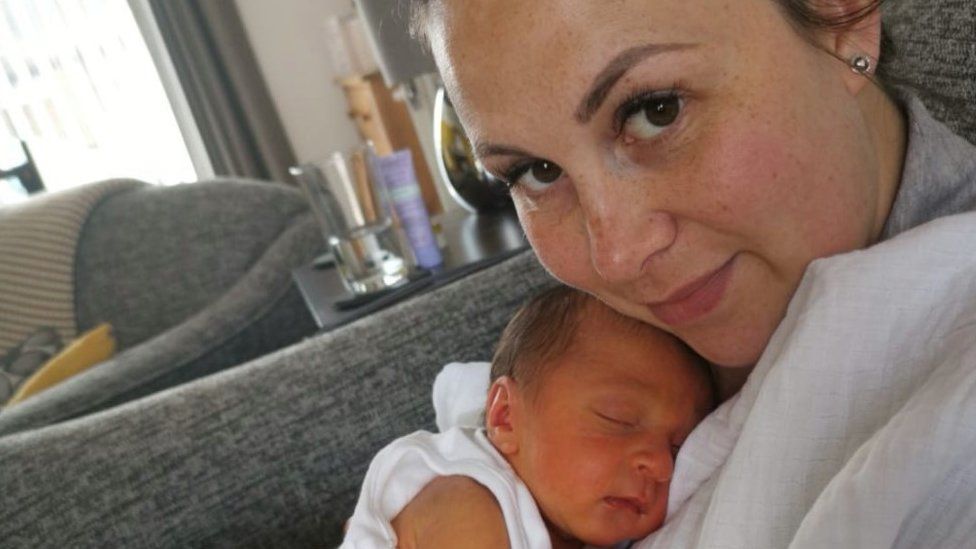A review led by the NHS Race and Health Observatory has raised significant concerns about a focus on skin colour in routine health checks for newborns.
The Apgar score, determined by a series of quick assessments immediately after birth, traditionally includes checking whether the baby is “pink all over”.
The report questions its relevance and accuracy for some babies belonging to ethnic minorities.
And it calls for an immediate update of maternity guidelines.
The wide-ranging review also looks at the diagnosis of newborn jaundice.
England’s former chief midwife Prof Jacqueline Dunkley-Bent, who now co-chairs the NHS Race and Health Observatory group working on maternal and neonatal health, said: “This biased assessment is exemplified by terms like ‘pink’ being used to describe a well-perfused baby [with good blood supply], disregarding the diversity of skin colours within our population.
“Consequently, it raises concerns about the clinical accuracy of such assessments when applied to ethnically diverse populations.”
Led by researchers from Sheffield Hallam University, the work reviews scientific literature and policies and involves interviews with 33 healthcare professionals and 24 parents.
First, it considers the Apgar score, devised in the 1950s.
Healthcare professionals check the baby’s muscle tone, pulse, reflex response, breathing rate and appearance, giving each component a maximum score of two.
This often includes assessing the baby’s appearance as:
- signs of blue (no points)
- completely pink (two points)
The lower the overall score, the more likely the baby is to need urgent help.
The review found:
- Most people interviewed said the language was inappropriate and needed to change
- Many – though not all – policies used words such as “pink”, “blue” or “pale” but most did not consider how this may be assessed on different skin tones
- Most healthcare professionals had, in practice, instinctively adapted the check, to look for colour changes around the lips, for example – but there was no consistent, evidence-based approach
- Experienced medics said they did not overly rely on a single part of the score in their assessment but it needed to be reviewed, particularly in training
Experts say alternative systems for checking wellbeing should be evaluated.
The report also says there are concerns about the “subjective nature” of guidelines for assessing jaundice – a yellowing of the skin, whites of the eyes and gums caused by a build-up of a substance called bilirubin.
All babies are checked for jaundice, in the first few days of life – often midwives will do a visual check together with an assessment of how alert a baby is and how well it is feeding.
Though it is common and often resolves on its own, jaundice can cause very serious problems if not treated at the right time. A blood test can check levels.
The review found:
- Most healthcare professionals said it was harder to identify jaundice in babies belonging to ethnic minorities, with some saying the level of jaundice was higher once identified
- Despite clinical guidance and clinicians recognising the problematic nature of using skin colour to assess jaundice in some babies, this awareness was not always translated into policy changes
The review says there is a need for more consistent training for healthcare staff and parents on how to spot jaundice in babies belonging to ethnic minorities and recommends establishing a national image database.


Lauren Clarke, a research practitioner in the East Midlands, had her son Jaxson in 2019.
She says by the time he was diagnosed with jaundice, when he was 6 days old, the levels were “very high and needed urgent treatment” but believes it should have been picked up and treated earlier.
Lauren said she noticed Jackson’s eyes and skin looked yellow in his first few days but when she approached staff about it they told her to “keep an eye”, with no further advice.
A midwife and two maternity support workers checked her baby visually after she went home but Lauren did not feel listened to.
It was only when she was admitted for treatment for a separate infection that staff on the ward did a blood test on Jaxson.
Lauren says when they got the results a junior doctor “took him immediately out of her arms” and gave him rapid light treatment.
Lauren told the BBC: “It was so hard when he was being treated with light therapy. I couldn’t feed him and he was crying so much.”
She added: “I think if he had not been mixed-race the jaundice would have been picked up sooner.”
The hospital held a review and said concerns about jaundice should have been escalated.
The review says the baby’s skin tone “may have made it more difficult to determine if the jaundice was getting worse.”
Recommendations included better training for staff and making more use of handheld meters to measure jaundice levels.



